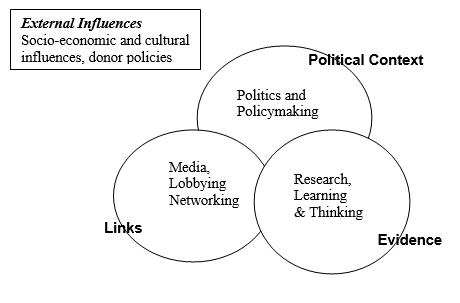4. The 'Context, Evidence, Links' Policy Framework
-

-


Category:
Recommended (depending on need)
Description and Purpose:
The below ‘context, evidence, links’ model was designed as a theoretical model to highlight to researchers the different factors that are important in the policy process. However, it also lends itself well to a project planning framework, and has been adapted for this purpose in the grid below: ‘How to influence policy and practice’.
Method:
The below model has been adapted to provide easy-to-follow guidance in the grid below it.
How to Influence Policy and Practice:
| What researchers need to know |
What researchers need to do |
How to do it |
Political Context:
- Who are the policymakers?
- Is there policymaker demand for new ideas?
- What are the sources/strengths of resistance?
- What is the policymaking process?
- What are the opportunities and timing for input?
|
- Get to know the policymakers, their agendas and their constraints
- Identify potential supporters and opponents.
- Keep an eye on the horizon and prepare for opportunities in regular policy processes.
- Look out for, and react to, unexpected policy windows
|
- Work with the policymakers.
- Seek commissions.
- Line up research programs with high-profile policy events
- Reserve resources to be able to move quickly to respond to policy windows
- Allow sufficient time and resources.
|
Evidence:
- What is the current theory?
- What are the prevailing narratives?
- How divergent is the new evidence?
- What sort of evidence will convince policymakers?
|
- Establish credibility over the long term.
- Provide practical solutions to problems.
- Establish legitimacy.
- Build a convincing case and present clear policy options.
- Package new ideas in familiar theory or narratives
- Communicate effectively.
|
- Build up programs of high quality work
- Action-research and Pilot projects to demonstrate benefits of new approaches.
- Use participatory approaches to help with legitimacy and implementation.
- Clear strategy for communication from the start.
- Face-to-face communication.
|
Links:
- Who are the key stakeholders?
- What links and networks exist between them?
- Who are the intermediaries and do they have influence?
- Whose side are they on?
|
- Get to know the donors, their priorities and constraints.
- Identify potential supporters, key individuals and networks.
- Establish credibility.
- Keep an eye on donor policy and look out for policy windows.
|
- Develop extensive background knowledge on donor policies
- Orient communications to suit donor priorities and language
- Cooperate with donors and seek commissions
- Contact (regularly) key individuals.
|
Adapted from Tools for Policy Impact: A Handbook for Researchers Overseas Development Institute (ODI)




